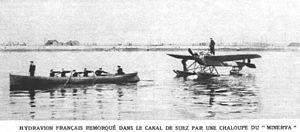Nieuport VI
| Nieuport VI | |
|---|---|
 |
|
| Role | Sport aircraft |
| National origin | France |
| Manufacturer | Nieuport |
| First flight | 1912 |
The Nieuport VI was a sport monoplane produced in France in the 1910s, a further development by Nieuport along the same general lines as the Nieuport II and Nieuport IV.
Like its predecessors, the Nieuport VI was a wire-braced, mid-wing monoplane of conventional design, powered by a single engine in the nose driving a tractor propeller. It differed, however, in being a three-seater rather than a single seater (a bench for two passengers fitted in tandem with the pilot's seat) and in using steel for part of its internal structure where earlier designs had used wood only. Produced initially as a seaplane and designated VI-G, it had twin pontoons as undercarriage, with a teardrop-shaped auxiliary float under the tail. The pontoons were fitted with small planes at either side of their nose ends to protect the propeller and to reduce the tendency for the nose ends of the floats to submerge while taxiing, and "stepped" keels. Since being a seaplane precluded the possibility of the pilot swinging the propeller by hand in order to start the engine, a crank was provided inside the cockpit that wound a spring that could be used to turn the engine over. The Type VI also featured a joystick for lateral control in place of the Blériot-style "cloche" controls used on earlier Nieuport designs.
A refined version was produced as the Nieuport VI-H with a revised empennage and other changes. This was operated by the French and British navies. A landplane version for military use was designated the Nieuport VI-M. Military Type VIs were built under licence in Italy by Macchi and in Russia.
First flown in April 1912, the type was flown competitively in August in a race meeting organised by the Automobile Club de France and the French maritime ministry on the bay at Saint-Malo. PIloted by Charles Weymann, the Nieuport finished fifth in the competition, collecting a FF 2,000 prize but also the "Jersey Speed Prize" for winning the course on day 3 of the competition, which involved a flight from Saint-Malo to Jersey and back that Weymann completed in 1 hour and 41 minutes. This success led to an order by the French Navy for seven machines, which were delivered to the Navy seaplane station at Saint-Raphaël in January the following year. The government of Japan also ordered three machines at this time, and orders from the governments of Italy, Russia, Sweden, and the United Kingdom were also received by the end of 1912. One month after the Saint-Malo event, a Type VI-G flown by Armand Gobé competed in trials at Tamise-sur-Escaut in Belgium, but finished tenth out of fifteen. Nieuport exhibited the type at the 1912 Salon de l'Aéronautique in Paris in December, and the aviation shows in Brussels and at Olympia in London in early 1913.
...
Wikipedia
